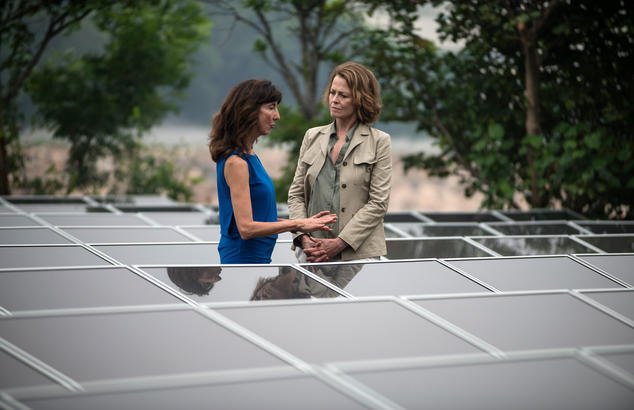The world needs a U.S.–China partnership to help stop global warming. But the presidential election has thrown the future of this alliance into question.
During the presidential race, it was one of Donald Trump's favorite refrains: China is beating us! Why are we letting them?
I don't agree with our president-elect on pretty much anything. But in at least one respect, I have to grudgingly admit that he's right. When it comes to curbing its dependence on coal and illustrating its commitment to renewable energy, it looks like China is about to clean our national clock.
I wish I could say that I thought Donald Trump was actually interested in winning this particular contest. But I'm deeply skeptical. With everything he's said and done up to this point—including his naming of Scott Pruitt, a climate denier and oil industry crony, as the next head of the U.S. Environmental Protection Agency—he has indicated that this is one victory he’s perfectly willing to cede to China.
And China, for what it's worth, has indicated that it's more than happy—not to mention more than ready—to take the lead.
It was only a few years ago that China seemed the unlikeliest of climate action standard-bearers. In 2014, the country also held the distinction of being responsible for more than one quarter of all global carbon emissions—more than the United States and the European Union combined. One prominent medical journal estimated that air pollution in China could be linked to between 350,000 and 500,000 premature deaths a year.
So mammoth was the nation's carbon footprint, in fact, that it was often cited by defenders of the fossil fuel status quo as a rationale for American inaction. Why should we break our backs reducing our emissions, people would ask, when China is just going to keep on burning coal like crazy and warming the planet anyway?
But the dramatic measures China has taken to cut emissions, reduce its reliance on coal, and invest in renewables over the past four years have shown this line of thinking to be spurious. There can now be no question that China—while still leading the world in both coal consumption and carbon emissions—is also leading the way forward to the clean-energy future.
In the Season 2 finale of The Years of Living Dangerously, which airs tomorrow night on the National Geographic Channel, the actress and activist Sigourney Weaver and I visit a giant power plant outside Hong Kong that exemplifies the sea change taking place within China right now. There we learn that this coal- and gas-fired facility—which basically powers all of metropolitan Hong Kong—will be 100 percent coal-free by 2030. That's the year by which China has committed to getting 20 percent of its primary energy from non-fossil-fuel sources.

© National Geographic/Years of Living Dangerously
As I said to Sigourney during our visit, China was investing almost no money at all in solar power as recently as five years ago. But it's very much worth noting the setting of our conversation: a massive array of 8,600 photovoltaic panels recently installed by the power plant as it sets about transitioning to clean energy production. The facility's manager points out that last year marked a major turning point: For the first time ever, China invested more in renewables like wind and solar—$100 billion—than it did in conventional sources of energy. That level of investment was more than enough to make China the world's top investor in clean energy. And over the next 14 years, the country plans to add as much wind and solar to its portfolio as currently exists on the planet.
But building the world's leading clean-energy economy will take more than just investing in wind and solar. It will also require the simultaneous phasing out of dirty fuels. Though China still consumes more coal than any other country (not all that surprising, given that it's the most populous nation on earth, with more than 1.3 billion residents), it has been decarbonizing at a furious rate. Chinese coal consumption began to level off about two years ago and is now steadily going down, year after year.
As a sign of just how seriously China is taking its commitment, the government recently canceled 30 new coal plants that were already under construction—the combined capacity of which would have been greater than the capacity of the United Kingdom's entire fleet. It also just set new targets to reduce coal consumption by 140 million tons in regions particularly affected by air pollution by 2020—an amount equivalent to the annual coal consumption of South Korea. And although the country recently loosened its strict curbs on coal production in order to deal with short-term shortages, coal output is still falling dramatically and is well below its 2013 peak.
During the Obama administration, China and the United States were engaged in a friendly rivalry on climate action that ended up redounding to the benefit of both nations—and, indeed, the entire world. Our two countries pushed each other to set and meet ambitious goals, and by our examples we inspired other countries to do the same.
Sadly, that relationship of friendly, mutually beneficial competition seems to be over—for now, at least. So far, president-elect Trump has given every sign that he would rather move backward, into our unsustainable past, than move forward—alongside China and other signatories to the Paris climate agreement—into the sustainable future. It's actually pretty ironic, given all of his campaign rhetoric about keeping and creating jobs. Were he to spend just a few minutes looking at the facts, he would see how China's commitment to clean energy has already resulted in 3.5 million new jobs in that sector.
Over the next four years, we can expect to see that number grow—just as we can expect to see Chinese air pollution and carbon emissions decline. What kinds of numbers can we expect to see from our own country, I wonder?


